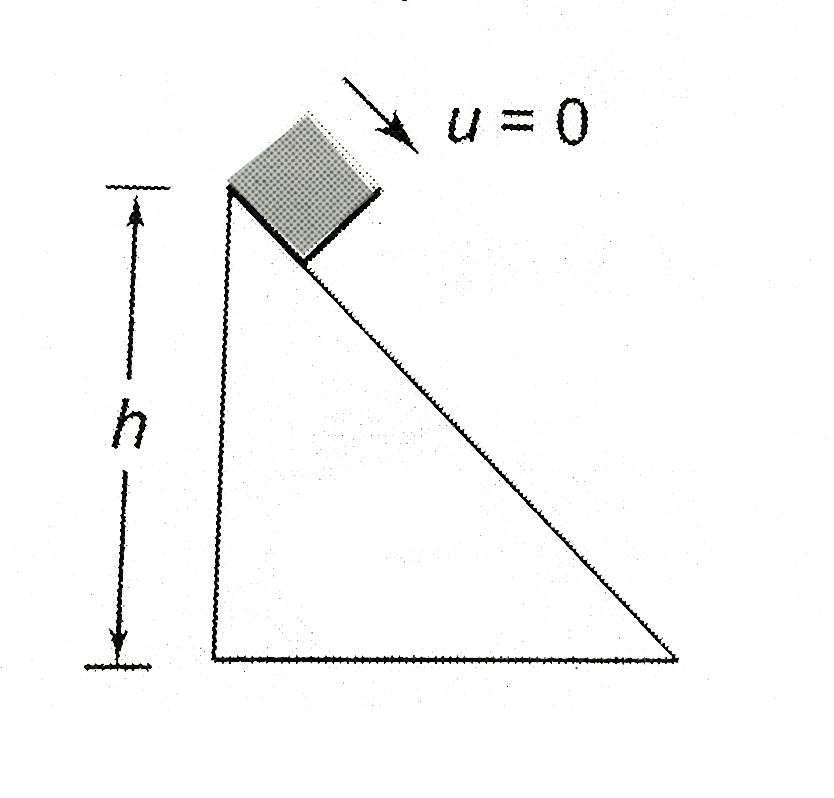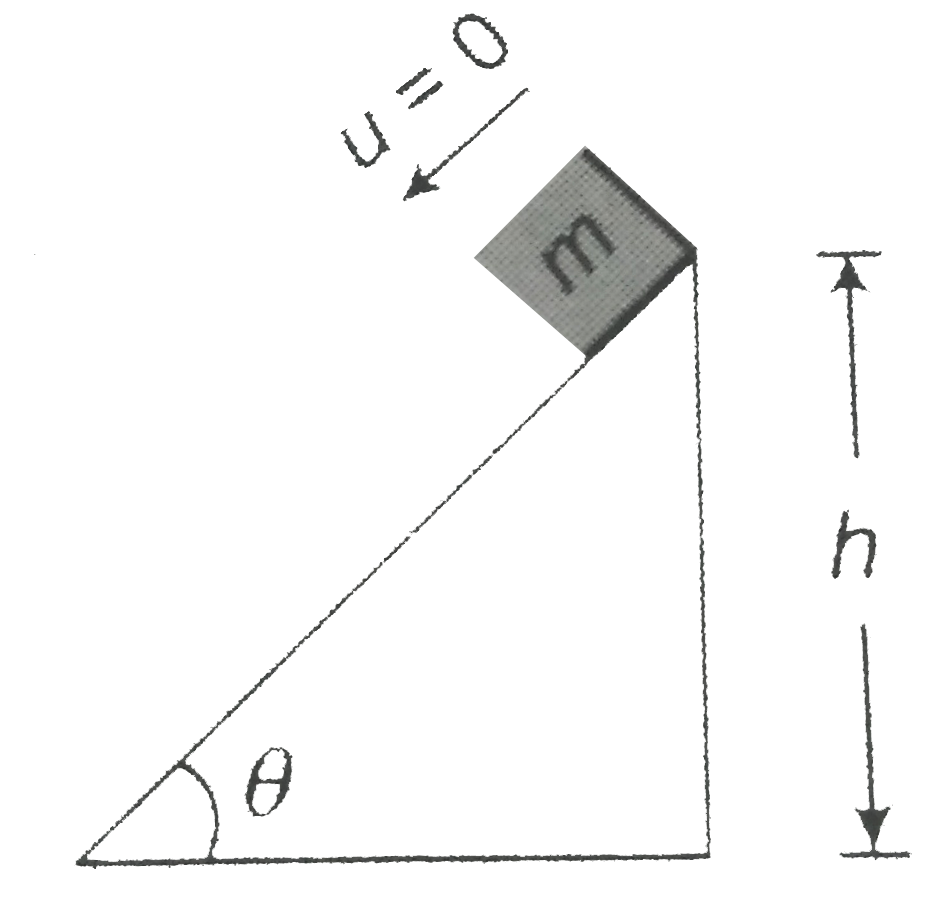A small block is freely sliding down from top of a smooth inclined plane. The block reaches bottom of inclined plane then the block describes a vertical circle of radius 0.5m along smooth track. The minimum vertical height of inclined plane should be
1m
1.25m
3m
2.5m
The correct Answer is:B
To solve the problem of finding the minimum vertical height of the inclined plane from which a block must slide to complete a vertical circle of radius 0.5 m, we can follow these steps:
Step 1: Understand the Energy Conservation Principle
When the block slides down the inclined plane, it converts its potential energy at the top into kinetic energy at the bottom. The total mechanical energy is conserved since there is no friction.
Step 2: Set Up the Energy Conservation Equation
Let the height of the inclined plane be h. The potential energy at the top (point A) is given by:
PEA=mgh
At the bottom (point B), the potential energy is zero, and the kinetic energy is:
KEB=12mv2
By conservation of energy:
PEA=KEB
Thus,
mgh=12mv2
Step 3: Simplify the Equation
We can cancel m from both sides (assuming m≠0):
gh=12v2
Rearranging gives:
v2=2gh
(1)
Step 4: Determine the Minimum Velocity for Vertical Circular Motion
For the block to complete a vertical circle, it must have a minimum velocity at the bottom of the circle. The minimum velocity vmin required at the bottom of the circle is given by:
vmin=√gr
where r is the radius of the circle (0.5 m in this case).
Step 5: Substitute the Radius
Substituting r=0.5 m into the equation for minimum velocity:
vmin=√g⋅0.5=√0.5g
Step 6: Relate the Two Velocities
From equation (1), we have:
v2=2gh
Now substituting vmin into this equation:
0.5g=2gh
Thus,
(0.5g)2=2gh
Substituting v2 gives:
0.5g=2gh
Step 7: Solve for Height h
Now we can equate:
2gh=0.5g
Cancelling g (assuming g≠0):
2h=0.5
Thus,
h=0.52=0.25 m
Step 8: Final Calculation for Minimum Height
Now, we need to find the height in terms of r:
h=5r2
Substituting r=0.5:
h=5⋅0.52=2.52=1.25 m
Conclusion
The minimum vertical height of the inclined plane should be 1.25 m.
---
When the block slides down the inclined plane, it converts its potential energy at the top into kinetic energy at the bottom. The total mechanical energy is conserved since there is no friction.
Let the height of the inclined plane be h. The potential energy at the top (point A) is given by:
PEA=mgh
At the bottom (point B), the potential energy is zero, and the kinetic energy is:
KEB=12mv2
By conservation of energy:
PEA=KEB
Thus,
mgh=12mv2
We can cancel m from both sides (assuming m≠0):
gh=12v2
Rearranging gives:
v2=2gh
(1)
For the block to complete a vertical circle, it must have a minimum velocity at the bottom of the circle. The minimum velocity vmin required at the bottom of the circle is given by:
vmin=√gr
where r is the radius of the circle (0.5 m in this case).
Substituting r=0.5 m into the equation for minimum velocity:
vmin=√g⋅0.5=√0.5g
From equation (1), we have:
v2=2gh
Now substituting vmin into this equation:
0.5g=2gh
Thus,
(0.5g)2=2gh
Substituting v2 gives:
0.5g=2gh
Now we can equate:
2gh=0.5g
Cancelling g (assuming g≠0):
2h=0.5
Thus,
h=0.52=0.25 m
Now, we need to find the height in terms of r:
h=5r2
Substituting r=0.5:
h=5⋅0.52=2.52=1.25 m
The minimum vertical height of the inclined plane should be 1.25 m.
Topper's Solved these Questions
Similar Questions
A ball of 1 gm released down an inclined plane describes a circle of radius 10 cm in the vertical plane on reaching the bottom . The minimum height of the inclined plane is … cm.
View SolutionA block is released from top of a smooth inclined plane.It reaches the bottom of the plane in 6 sec.The time taken by the body to cover the first half of the inclined plane is:
View Solution
Knowledge Check
- Question 1 - Select One
A block is freely sliding down from a vertical height 4m on smooth inclined plane. The block reaches bottom of inclined plane and then it decribes vertical circle of radius 1m along smooth track. The ratio of normal reactions on the block while it crossing lowest point and highest point of vertical circle is
A6:1B5:1C3:1D5:2 - Question 2 - Select One
A block of mass m is released from the top of a mooth inclined plane of height h its speed at the bottom of the plane is proportion to
Am0BmCm2Dm−1 - Question 3 - Select One
A block slides down a smooth inclined plane when released from the top, while another falls freely from the same point :
Asliding block will reach the ground first with greater speedBfreely falling block will reach the ground first with greater speedCboth the blocks will reach the ground at the same time but with different speedsDboth the blocks will reach the ground with same speed but the freely falling block first
A block is released from top of a smooth inclined plane It reaches the bottom of the plane in √2s The time taken (in second) by the body to cover Ist half of inclined plane is .
View Solution
A block is released from the top of the smooth inclined plane of height h. Find the speed of the block as it reaches the bottom of the plane.View SolutionA block is released on an smooth inclined plane of inclination θ. After how much time it reaches to the bottom of the plane?
 View Solution
View SolutionA block of mass m is released from the top of fixed inclined smooth plane. if theta is the angle of inclination then vertical accelertion of block is
View SolutionA ball of mass 100 g released down an inclined plane describes a circle of radius 10 cm in the vertical plane on reaching the bottom of the inclined plane . The minimum height of the incline is
View Solution

